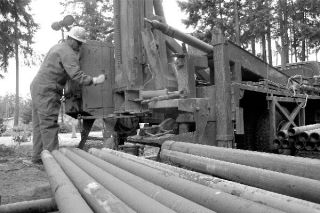The county’s innovative system used to extract gases from the original and now defunct Coupeville landfill will soon receive vital upgrades.
Roughly 380,000 tons of refuse — the result of 40 years of dumping — resides on county-owned property at the transfer station south of the town. The county became the overseers of the waste when it purchased the land in 1971.
The refuse accumulation continued during the subsequent operation of the county’s solid waste landfill from 1971 to 1992, and demolition landfill from 1990 to 2000.
The original gas extraction system was installed in 1992 for $1.5 million and upgraded in 2004 for a similar sum. The most recent system upgrade was designed to increase the efficiency of landfill gas removal and begin extracting additional vapors generated in native soils below the waste.
The project also included installation of in-waste extraction wells, groundwater monitoring wells and gas detection probes.
Dave Bonvouloir, Island County Solid Waste manager, told the Board of Island County Commissioners at Wednesday’s staff session that data from 2005 to 2007 has quantified the overall success of the system’s upgrades.
“Many of the groundwater wells show an overall quality improvement with decreases in impacts from gas that is being removed at a higher rate,” he said. “The 2004 upgrades are doing well.”
However, one monitoring well — located closest to the landfill — has continued to be a particular problem, and a couple of its subterranean cohorts are not performing as well as expected.
“That area and well has always been troublesome and we don’t really know why,” Bonvouloir said, adding that further upgrades designed to augment the extraction capabilities are a priority.
The solid waste manager said on the positive side, the detected impacts appear to be gas-related and not leachate, or water that collects contaminants as it trickles through waste.
Bonvouloir recommended installing engineered improvements, including an additional native soil gas extraction well uphill from the problem area, in addition to placing two deep gas probes in strategic positions, and groundwater monitoring wells downhill from the impacted wells. New flow meters and monitoring equipment upgrades will improve other system functions.
“We’re hoping that will take care of it,” Bonvouloir said. The gas created by the landfill has decreased annually and should be almost depleted in 25 years assuming no additional moisture finds its way into the contained landfill. The clock started 15 years ago when the landfill was originally sealed.
“Gas production should continue to decrease to very minimal amounts, but it will always be our responsibility,” Bonvouloir said. “We have to continue to be proactive.”
Commissioner Phil Bakke asked about the plausibility of excavating the landfill and physically removing the garbage. Bonvouloir said the landfill, although comparatively small, would require a project of a magnitude that would be cost prohibitive. “It would be tens of millions of dollars,” he said.
SCS Engineers, “on-call” for the $170,000 upgrade project, began work last Thursday.



